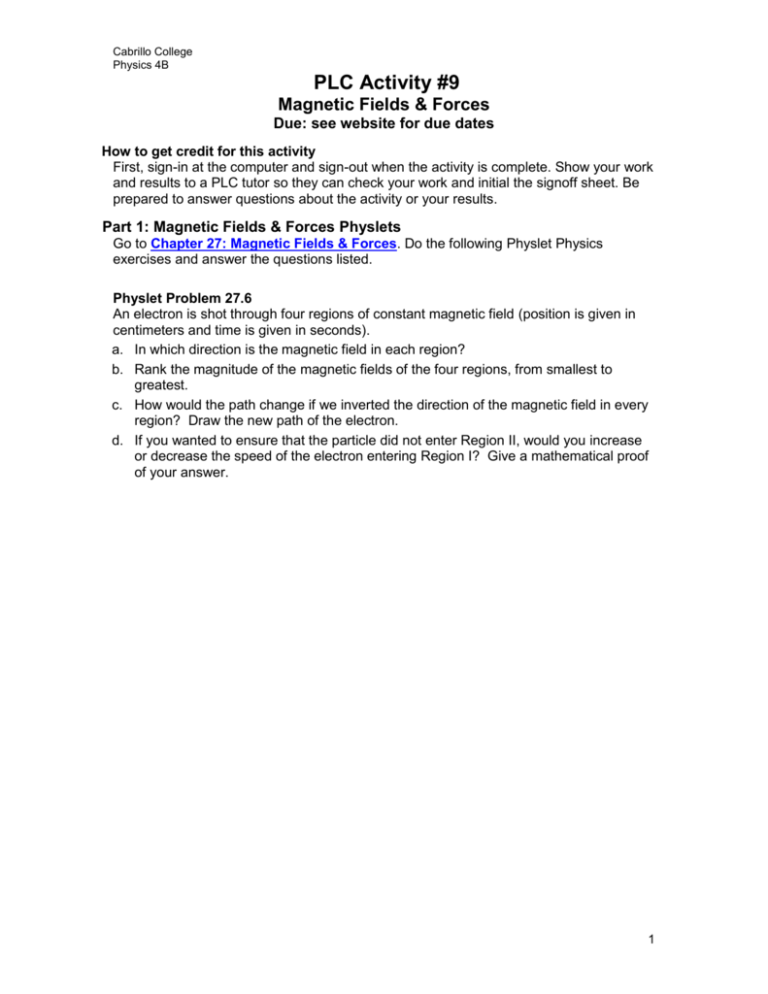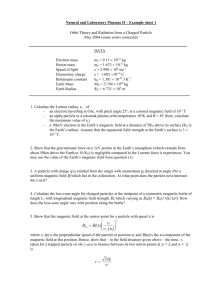9 - Cabrillo College
advertisement

Cabrillo College Physics 4B PLC Activity #9 Magnetic Fields & Forces Due: see website for due dates How to get credit for this activity First, sign-in at the computer and sign-out when the activity is complete. Show your work and results to a PLC tutor so they can check your work and initial the signoff sheet. Be prepared to answer questions about the activity or your results. Part 1: Magnetic Fields & Forces Physlets Go to Chapter 27: Magnetic Fields & Forces. Do the following Physlet Physics exercises and answer the questions listed. Physlet Problem 27.6 An electron is shot through four regions of constant magnetic field (position is given in centimeters and time is given in seconds). a. In which direction is the magnetic field in each region? b. Rank the magnitude of the magnetic fields of the four regions, from smallest to greatest. c. How would the path change if we inverted the direction of the magnetic field in every region? Draw the new path of the electron. d. If you wanted to ensure that the particle did not enter Region II, would you increase or decrease the speed of the electron entering Region I? Give a mathematical proof of your answer. 1 Physlet Problem 27.8 The animation shows a particle passing through a mass spectrometer (position is given in meters and time is given in seconds). There is a constant magnetic field throughout the region directed into the screen. There is a constant electric field in the first region only. a. Is the particle charged? How do you know? If it is charged, does it have a positive or negative charge? Justify your answer. b. If the electric field produced by the charged plates in the first region is 80 N/C, what is the value of the magnetic field in that region? c. What is the charge to mass ratio (q/m) of the particle? Physlet Problem 27.7 Six objects (all with a mass of 5 grams) are shot into a region of constant magnetic field. The blue object has a charge of 6 mC. The position and velocity of the blue object are given in the table (position is given in centimeters and time is given in seconds). All objects are located at x = 50 cm at time t = 0 s. a. Rank the objects based on their velocity when they first encounter the magnetic field, from lowest to highest. Calculate the speeds to confirm your rankings. b. How does the magnitude of the velocity of each object change as it interacts with the magnetic field? c. Rank the objects based on their charge, from lowest to highest. Calculate the charges to confirm your rankings d. What are the direction and magnitude of the magnetic field? 2 Physlet Problem 27.10 The blue rod has a current flowing through it and sits in a uniform external magnetic field that points out of the page (as represented by the gray circles with white dots). The probe at the top records the force required to support the rod (position is given in centimeters, magnetic field is given in Tesla, current is given in amperes, and force is given in newtons). a. In which direction does the current flow through the rod? b. What is the mass of the rod? Part 2: Ranking Problems Question 1 The figure shows crossed and uniform electric and magnetic fields E and B, at a certain instant, the velocity vectors of the 10 charged particles listed in Table. (The vectors are not drawn to scale.) The table gives the signs of the charges and the speeds of the particles; the speeds are given as either less than or greater than E/B. Which particles will move out of the page toward you after the instant? Particle Charge Speed 1 2 3 4 5 Less Greater Less Greater Less + + + + - Particle Charge 6 7 8 9 10 + + - Speed Greater Less Greater Less Greater Question 2 The figure shows the path of a particle through six regions of uniform magnetic field, where the path is either a half-circle or a quarter-circle. Upon leaving the last region, the particle travels between two charged, parallel plates and is deflected toward the plate of higher potential. What are the directions of the magnetic fields in the six regions? 3 Question 3 The figure shows 11 paths through a region of uniform magnetic field. One path is a straight line; the rest are half-circles. The Table gives the masses, charges, and speeds of 11 particles that take these paths through the field in the directions shown. Which path in the figure corresponds to which particle in the table? Particle Mass Charge Speed 1 2m q v 2 m 2q v 3 m/2 q 2v 4 3m 3q 3v 5 2m q 2v 6 m -q 2v 7 m -4q v 8 m -q v 9 2m -2q 3v 10 m -2q 8v 11 3m 0 3v Question 4 The figure shows eight wires that carry identical currents through the same uniform magnetic field (directed into the page) in eight separate experiments. Each wire consists of two straight sections (each of length L and either parallel or perpendicular to the x and y axes shown) and one curved section (with radius of curvature R). The directions of the currents through the wires are indicated by the arrows next to the wires. (a) Give the direction of the net magnetic force on each wire in terms of an angle measured counterclockwise from the positive direction of the x axis. (b) Rank wires 1 through 4 according to the magnitude of the net magnetic force on them, greatest first. (c) Do the same type of ranking for wires 5 through 8. 4 5









